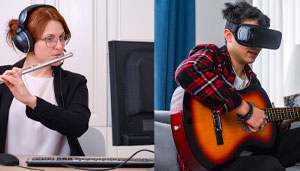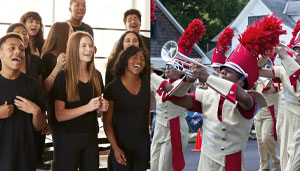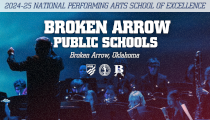Students Become Leaders! Including More Student Led Activities In A Large Ensemble Setting
By Elisabeth R. Sato / TEMPO Magazine on November 05, 2021 music directors & adjudicators article Print
How might we encourage more leadership from our students within a traditional large ensemble setting? As an orchestra teacher at the high school level, this is a question I frequently ask myself. I would like to share with you some of the instructional activities I included in my traditional large ensemble setting last school year to create more leadership opportunities for my students in high school orchestra. I hope to give you some new ideas to try in your own teaching setting!
Sectionals
Sectionals provide a great opportunity for students to take on leadership roles, and many music educators currently have students work in sectionals. By dividing students by instrument or instrument part, they can focus on any tricky passages within that specific part. Principal players or section leaders can take the lead by facilitating the rehearsal, which may also encourage peer learning and mentorship, especially within a mixed grade and level ensemble. On days when we had sectionals, I might have all students rehearse within their sections simultaneously or have only one or two sections rehearse in sectionals while the remaining students in the orchestra rehearsed as a whole ensemble.
Mini Orchestra Mission
To take sectionals a step further, I included a new activity in my teaching last school year that I named the “Mini Orchestra Mission” and was originally suggested to me by a colleague. Instead of dividing students by instrument or instrument part, students were assigned to a mixed small ensemble consisting of all parts in the orchestra. They were provided with a “mission,” (I assigned specific sections from our concert repertoire), and had to rehearse and record the assigned sections and submit the recordings electronically at the end of the class period. Having the students record their playing may have also helped with rehearsal productivity. Each time we did this activity, I would try and vary the ensemble sizes and change the ensemble formations so the students would get the chance to work with different members of the orchestra.
The Mini Orchestra Mission activity encourages students to play more independently, and in a sense, become their own leader. Instead of relying on a whole section, only one or two students might be playing the same part. Students must also work together to identify problematic areas, rehearse their music together, and evaluate their own playing. By strategically forming the mini orchestras, you may even see new students become leaders!
This activity was also very informational for me as the teacher because I could get a better sense of areas in our music that might require further attention. When I listened to each mini orchestra’s recording, I could hear specific sections in the music where students had trouble and use these recordings to help guide my own instruction. I would focus on these areas when we met again as a whole ensemble, or if I noticed a pattern in a specific instrument part, that area could become the focus for sectionals or small group lessons.
Student Conductors
Having students conduct gives them the chance to lead the entire ensemble and also learn a new skill. For an annual performance, the orchestra has performed the same tunes every school year. Since most students were quite familiar with these pieces, I decided to offer the upperclassmen the opportunity to conduct the performance since they were the most familiar with the tunes.
I made a list of some of the tunes and created a sign-up sheet where the students could choose the piece they wanted to conduct. When we worked on these pieces during our rehearsal period, the student conductors would step up to the podium one after the other, conduct their piece, and rehearse specific sections if they chose to. While the students conducted, I could move around the room and sit in different sections of the orchestra and play along. By doing this, I was also able to assist some students if they were having trouble with any of the pieces.
Student-Coached Chamber Ensembles
A new activity I included in my instruction last school year was student-coached chamber ensembles. Providing students with more chamber music opportunities was an area I wanted to include more of in my teaching, but always found to be difficult in the large ensemble setting. However, by structuring the experience, I was able to build this into my instruction. One of the aims for this activity was to provide more experienced orchestra students with an opportunity to take on a new leadership role and have a new type of learning experience, while less experienced students would have the opportunity to participate in a small chamber ensemble. Because this experience was new for the younger students, I thought it might be more beneficial to have a more experienced student as a coach to help guide the rehearsals.
I assigned younger students in the orchestra to small chamber ensembles based on similar playing ability, and each ensemble was assigned at least one upperclassman student as a coach. Prior to the start of coaching sessions, I met with all student coaches to discuss score study and some strategies they could use when facilitating a small chamber ensemble rehearsal. For repertoire, I selected 4-5 level appropriate pieces of music for each ensemble and gave the ensembles the choice of what they wanted to play. The chamber ensembles rehearsed once a week during the regular instructional period. After each rehearsal, I asked students to submit a rehearsal reflection summary to summarize what they had focused on during that rehearsal. Also included in the reflections were items such as areas of improvement and successful and unsuccessful moments.
The chamber ensembles rehearsed for just over three months. Within that time frame, I was able to arrange several informal and formal performance opportunities such as performing for the orchestra members during class and traveling to another school in the district to perform. At the conclusion of the student-coached chamber ensemble experience, I scheduled an evening “final presentation” where the ensembles performed for their parents and guardians. The night was definitely a nice way to highlight all of the students and chamber ensembles!
Conclusion
Including more student-led activities such as sectionals, student conductors, and student-coached chamber ensembles into instruction can provide students with leadership opportunities in a traditional large ensemble setting. By participating in these activities, students can learn new skills and become more independent musicians. Including these into instruction can also be beneficial for the teacher because they provide an outside view of the ensemble that can help guide and influence future instruction. All of these activities can help students become leaders and contribute to new and meaningful music-making experiences.
Elisabeth R. Sato / TEMPO Magazine
This article first appeared in the TEMPO, January 2020 edition. The New Jersey Music Educators association provides programs and activities for professional educators, students and future music educators striving to enhance the quality of music education for all children. Check out the New Jersey Music Educators Association here: (https://njmea.org/)
Elisabeth R. Sato
Teachers College, Columbia University
Most Recent Articles







